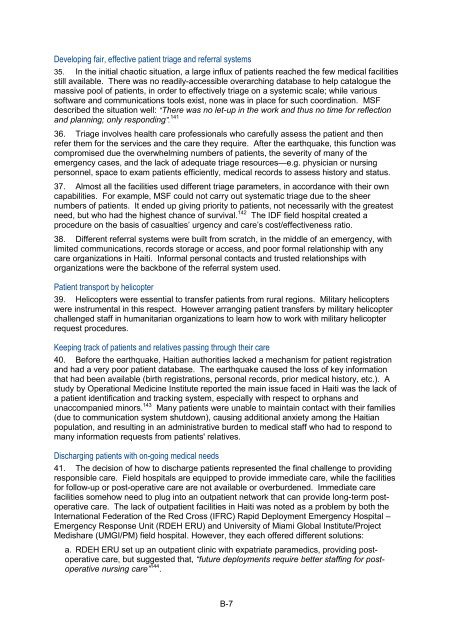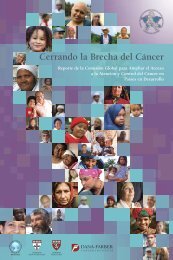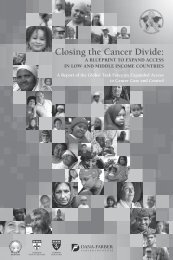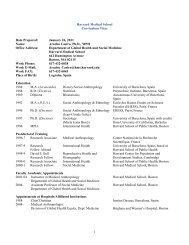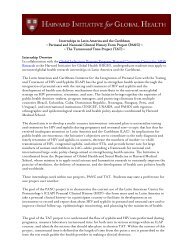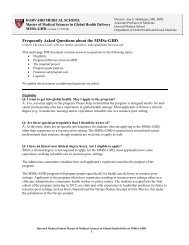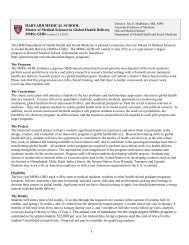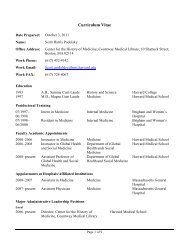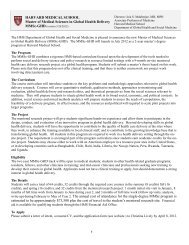Haiti Case Study - The Department of Global Health and Social ...
Haiti Case Study - The Department of Global Health and Social ...
Haiti Case Study - The Department of Global Health and Social ...
You also want an ePaper? Increase the reach of your titles
YUMPU automatically turns print PDFs into web optimized ePapers that Google loves.
Developing fair, effective patient triage <strong>and</strong> referral systems<br />
35. In the initial chaotic situation, a large influx <strong>of</strong> patients reached the few medical facilities<br />
still available. <strong>The</strong>re was no readily-accessible overarching database to help catalogue the<br />
massive pool <strong>of</strong> patients, in order to effectively triage on a systemic scale; while various<br />
s<strong>of</strong>tware <strong>and</strong> communications tools exist, none was in place for such coordination. MSF<br />
described the situation well: “<strong>The</strong>re was no let-up in the work <strong>and</strong> thus no time for reflection<br />
<strong>and</strong> planning; only responding”. 141<br />
36. Triage involves health care pr<strong>of</strong>essionals who carefully assess the patient <strong>and</strong> then<br />
refer them for the services <strong>and</strong> the care they require. After the earthquake, this function was<br />
compromised due the overwhelming numbers <strong>of</strong> patients, the severity <strong>of</strong> many <strong>of</strong> the<br />
emergency cases, <strong>and</strong> the lack <strong>of</strong> adequate triage resources—e.g. physician or nursing<br />
personnel, space to exam patients efficiently, medical records to assess history <strong>and</strong> status.<br />
37. Almost all the facilities used different triage parameters, in accordance with their own<br />
capabilities. For example, MSF could not carry out systematic triage due to the sheer<br />
numbers <strong>of</strong> patients. It ended up giving priority to patients, not necessarily with the greatest<br />
need, but who had the highest chance <strong>of</strong> survival. 142 <strong>The</strong> IDF field hospital created a<br />
procedure on the basis <strong>of</strong> casualties’ urgency <strong>and</strong> care’s cost/effectiveness ratio.<br />
38. Different referral systems were built from scratch, in the middle <strong>of</strong> an emergency, with<br />
limited communications, records storage or access, <strong>and</strong> poor formal relationship with any<br />
care organizations in <strong>Haiti</strong>. Informal personal contacts <strong>and</strong> trusted relationships with<br />
organizations were the backbone <strong>of</strong> the referral system used.<br />
Patient transport by helicopter<br />
39. Helicopters were essential to transfer patients from rural regions. Military helicopters<br />
were instrumental in this respect. However arranging patient transfers by military helicopter<br />
challenged staff in humanitarian organizations to learn how to work with military helicopter<br />
request procedures.<br />
Keeping track <strong>of</strong> patients <strong>and</strong> relatives passing through their care<br />
40. Before the earthquake, <strong>Haiti</strong>an authorities lacked a mechanism for patient registration<br />
<strong>and</strong> had a very poor patient database. <strong>The</strong> earthquake caused the loss <strong>of</strong> key information<br />
that had been available (birth registrations, personal records, prior medical history, etc.). A<br />
study by Operational Medicine Institute reported the main issue faced in <strong>Haiti</strong> was the lack <strong>of</strong><br />
a patient identification <strong>and</strong> tracking system, especially with respect to orphans <strong>and</strong><br />
unaccompanied minors. 143 Many patients were unable to maintain contact with their families<br />
(due to communication system shutdown), causing additional anxiety among the <strong>Haiti</strong>an<br />
population, <strong>and</strong> resulting in an administrative burden to medical staff who had to respond to<br />
many information requests from patients' relatives.<br />
Discharging patients with on-going medical needs<br />
41. <strong>The</strong> decision <strong>of</strong> how to discharge patients represented the final challenge to providing<br />
responsible care. Field hospitals are equipped to provide immediate care, while the facilities<br />
for follow-up or post-operative care are not available or overburdened. Immediate care<br />
facilities somehow need to plug into an outpatient network that can provide long-term postoperative<br />
care. <strong>The</strong> lack <strong>of</strong> outpatient facilities in <strong>Haiti</strong> was noted as a problem by both the<br />
International Federation <strong>of</strong> the Red Cross (IFRC) Rapid Deployment Emergency Hospital –<br />
Emergency Response Unit (RDEH ERU) <strong>and</strong> University <strong>of</strong> Miami <strong>Global</strong> Institute/Project<br />
Medishare (UMGI/PM) field hospital. However, they each <strong>of</strong>fered different solutions:<br />
a. RDEH ERU set up an outpatient clinic with expatriate paramedics, providing postoperative<br />
care, but suggested that, “future deployments require better staffing for postoperative<br />
nursing care” 144 .<br />
B-7


